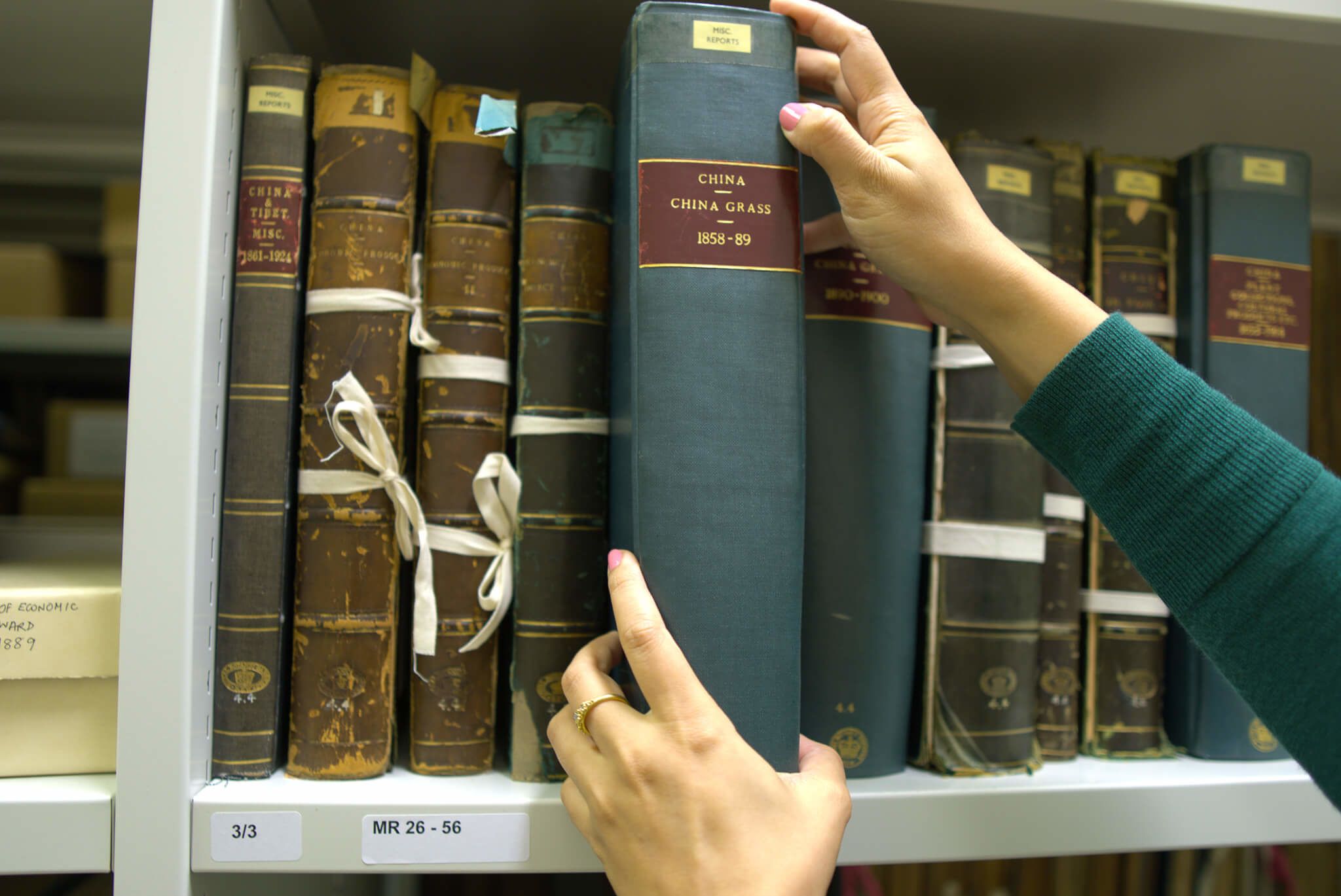
Creative explorations and botanical imaginations at Kew Gardens

- Written byAnushka Tay
- Published date 24 November 2022

LCF PhD student Anushka Tay reports back on her research placement and artist residency at the Archive of the Royal Botanic Gardens, Kew.
Since the summer, I have been researching the histories and journeys of plant collection across East Asia at the Archive of the Royal Botanical Gardens, Kew. My exhibition ‘Curious & Miscellaneous’ is now on at the Library & Archive Reading Room until 26 January 2023. Concentrating on their historical materials from the mid-19th to early-20th centuries, I had an initial focus on uses of plant textiles in China. Yet as so often happens in archives, once I began engaging with the materials in earnest I found my imagination stimulated by the many possibilities embedded within the documents, and my research meandered outwards in all kinds of directions.
I responded to the historical materials in my sketchbook, writing, painting, and composing music. Of course I had to keep some connection to my textile roots, and I also knitted a sock.
Engaging with the archive
This project involved working with 11 volumes of a 772-volume collection called the Miscellaneous Reports. These document Kew’s correspondence with a vast network of botanical gardens, plant collectors and government agents around the world. The Miscellaneous Reports are arranged geographically and contain a mixture of different types of materials. From letters, press clippings and packing notes for specimens shipped to Kew Gardens; to catalogues and brochures, samples of fibres, plantation share certificates - and undoubtedly much more to still discover within. The collection spans the reach of European colonialism; thus for example, there are many volumes of materials from India and the Caribbean, but fewer concerning countries in Europe itself.
I soon felt the stories lying dormant within the collection. These stories are not necessarily about the Europeans living in China, who wrote to Kew Gardens and sent specimens for the Kew Museum during this period. Rather, I found myself constantly searching for the Chinese people who are so present in all of the materials, and whose knowledge was generously shared - yet who were rarely directly named. Occasionally they are depicted in illustrations; or described in reports of long journeys through rural and mountainous paths. I felt that they were begging me to lift them off the page.
Creative responses to historical research
Devising my artistic responses to the materials involved an open-ended process of experimentation and play. It was wonderful to do this amongst the backdrop of Kew Gardens, where I rambled about this summer, taking field recordings with my Dictaphone and far, far too many photos of flowers and foliage.
My PhD here at LCF is theoretical, researching Chinese diaspora dress histories. Through this residency at the Archive, I was able to unite my ongoing personal practice – across music and making – with academic research.
At times I approached it as a call-and-response: the historical letters and Chinese botanical illustrations used inks, so I painted in my sketchbook using coloured ink, brushes and a dip-pen. I discovered a commercial factory sample of a sock made from ramie from 1908; so I knitted a sock using a ramie-blend yarn, 114 years later in 2022. And I turned my impressions of the scenes described into several pieces of music on piano and voice, using a microphone and a looper and cutting in vocal improvisations, sounds recorded around Kew Gardens, and quotes from the Miscellaneous Reports.
Curating the exhibition
Through the curation of my exhibition Curious & Miscellaneous, I traced many of the objects and plant specimens which had been sent to Kew during this period, but which were subsequently separated and held in different collections. I was able to reunite the collectors, objects and plants, and display many items from Kew’s collection including dried plant specimens from the Herbarium, botanical illustrations, and much more. I show these alongside my own creative works.
The exhibition is now open to the public, and I hope that through it, my work has drawn out the many of the unheard voices of people who were always present in the materials – only waiting to come out.
Thank you very much to the staff at the Library & Archive and Economic Botany departments at the Royal Botanic Gardens, Kew; and to Techne Doctoral Training Partnership for funding this placement.

Visit the exhibition
Curious & Miscellaneous. New Work and Archival Encounters by Anushka Tay.
Library & Archive Reading Room, Herbarium Building, RBG Kew (closest stations Kew Bridge and Kew Gardens)
Tuesday-Thursday, 10am-4pm
Open until 26th January 2023
Free entry, contact library@kew.org to arrange your visit, or simply drop in to visit during Reading Room opening hours.

Related links
- Watch a YouTube video about the Miscellaneous Reports
- View the full Miscellaneous Reports catalogue
- Visit the Library & Archives Reading Room
- Find out more about Kew's Collections
- View Anushka's website
- Follow Anushka on Twitter
- UAL Post-Grad Community
UAL Post-Grad Community
Established in 2013, Post-Grad Community is an inclusive platform for all UAL postgraduate students to share work, find opportunities and connect with other creatives within the UAL and beyond. Find out more